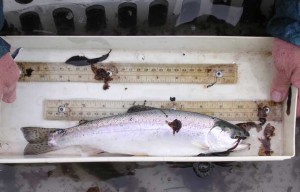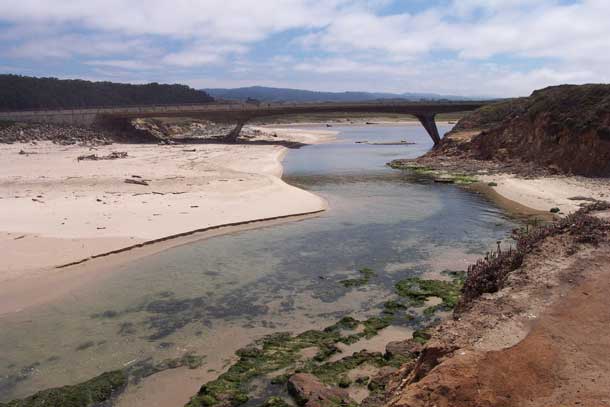On Wednesday, September 12, officials from several state and federal agencies will hold a public briefing to explain a new, if low-tech, effort to head off a twelfth straight year of fish kills at Pescadero Marsh State Beach.
For the past 11 years, and 13 of the last 17, federally protected steelhead trout have died here due to a fatal mix of low oxygen and quickly changing water levels, says Patrick Rutten, field supervisor for the National Oceanic and Atmospheric Administration’s Restoration Center in Santa Rosa.
Each fall, a sandbar forms across the mouth of the lagoon where it meets the ocean. In the ensuing weeks, small amounts of fresh water flow in from upstream, but mostly the lagoon sits stagnant, with a layer of oxygen-depleted (anoxic) water building at its bottom.
Normally, fish simply avoid that anoxic zone, but when the rains start and the sandbar is naturally breached, the upper layer of oxygen-rich water rushes out, leaving the fish with nowhere to go but straight into a zone where they can’t breathe. Last year, 243 federally threatened steelhead perished here immediately after the sandbar broke in late November.

“This is really the first time that we have said that we’re not going to sit back any longer and that’s why we’re going to try something,” says Rutten. “Those fish are listed under the Endangered Species Act, and they are very big, healthy fish.”
The proposed action is surprisingly simple: Once or twice this fall, likely in late September or early October, crews of agency employees and volunteers will dig an eight-foot-wide, one-foot-deep trench by hand to open the lagoon to the ocean.
“What we’re trying to do with this project is to open that bar before the system gets completely full,” Rutten explains, “to do a reset on the lagoon filling that gets us far enough into the winter that we get enough fresh water to create a larger area that doesn’t have the same anoxic [low oxygen] conditions.”
A local citizens group, the Coastal Alliance for Species Enhancement, has been pushing for a fix for the annual fish kills for years. Board member Peter Congdon says he’s “cautiously optimistic” about the latest plan. “We have a good working relationship with NOAA, and we’ve got our fingers crossed for this temporary fix,” he says.
One reason this remedy has been slow in coming is that so many agencies are involved in management of the marsh, including the state parks department, state Department of Fish and Game, the local water district, the U.S. Fish and Wildlife Service, and NOAA.
And then there’s simply the unusual circumstances of this place: eight protected plant species and 10 protected animal species, including the endangered tidewater goby and San Francisco garter snake. The Wall Street Journal reported in 2010 that a plan to help the steelhead by installing aerators was scuttled due to concerns that it could harm the goby. The marsh is also home to western pond turtles, a state species of special concern, and it’s considered potential coho salmon habitat (stay tuned for a feature on San Mateo-Santa Cruz coho in our forthcoming October-December 2012 issue).

Breaching lagoons is not something the U.S. Fish and Wildlife Service or NOAA generally advise — or would even allow when it comes to protected species. “We don’t support of the breaching of lagoons,” says Rutten, “since 45 percent of steelhead growth happens in those lagoons. But in this location under these circumstances, we’re going to almost certainly see a fish kill [if the breach isn’t carried out].”
How did the fish survive here over decades and centuries before? Well, “here” has changed quite a bit: “What we’re seeing is probably a legacy of human intervention and management of that system,” says Rutten. “They used to farm potatoes down there and they used to burn. There was a concession for rowboats. There’s been a lot of leveeing. There’s also a significant amount of legacy sediment from the Butano Creek watershed, from logging probably in the 1920s.”
But Congdon places the blame for the fish kills specifically on a restoration project implemented by the state parks department in the mid-1990s, and his group is pushing for the the federal courts to find the state parks liable for illegal take of protected steelhead, which might force more drastic measures to avoid future fish kills.
Of the past restoration effort, State Parks spokesperson Roy Stearns says, “There was an honest attempt to try to address the problem. Whether it worked or not, I don’t know. This is a committed partnership where state parks is saying it’s time to step up to the plate and see what works. This is a complex system and there’s no guarantees that it will or won’t work.” The affects of the sandbar breaching this fall will be monitored, with data turned over to an independent science panel to interpret the data and suggest further actions. “That data should inform us on what to do in the future,” says Stearns, “but there’s no guarantee of that yet.”
The public briefing briefing is on Wednesday, September 12, 2012 at 2 p.m. at the parking lot off Highway 1 that overlooks the lagoon, on the ocean side of Highway 1, approximately 200 yards north of the intersection of Highway 1 and Pescadero Road. Here’s a map.
Read the U.S. Fish and Wildlife Service’s press release about Wednesday’s briefing.





